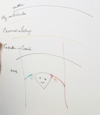Cerebellum Flashcards
(142 cards)
3 principle motor functions of cerebellum
Tone
Posture and balance
Co-ordination of movements
From which emrbyological precursor does cerebellum arise?
From metencerphalic portion of rhombencephalon
What are the three principle lobes of cerebellum
Anterior
Posterior
Flocullus

Function of flocculonodular lobe
Balance (most primitive) of head and eyes
Archicerebellum=
Floculonodular lobe
Paleocerebellum=
Anterior lobe
Function of anterior lobe of cerebellum?
Tone
Neocerebellum=
Posterior lobe
Function of posterior lobe
Co-ordination of movement
Which fissure divides anterior and posterior cerebellar lobes?
Primary fissure
Which fissure separates posterior lobe from floculonodular lobe
Posterolateral fissure
What is the name of the area of the cerebellum adjacent to the vermis?
Paravermal area/ Intermediate zone

What is the arrangement of the sensory homunculus of the cerebellum

In which portion of the cerebellum is the control of trunk and axial musculature found?
Vermal area
Where in the cerebellum is the control of the hands or feet?
Paravermal area
What are the two types of grey matter in the cerebellum?
Cerebellar cortex
Deep cerebellar nuclei
How can the afferent fibres to cerebellum be classified?
Those coming from alll portions of CNS - mossy fibres
Those coming from inferior olivary nucleus (olivocerebellar fibres- climbing fibres)
Spartans are climbing the olive tree to cerebellar cortex
Olivocerebellar fibres= climbing fibres
Spartans- contain aspartate
All fibres which enter cerebellum are
Exctitatory
Which neurotransmitters are released by mossy fibres?
Glutamate
Layers of cerebellar cortex
My
Personal
Garden
Molecular
Purkinje
Granular
With what must all fibres entering cerebllar cortex synapse before entering cortex?
Deep cerebellar nuclei

With what deeper structure do cells from the purkinje layer synapse?
Is this inhibitory or excitatory?
Deep cerebellar nuclei
Inhibitory (GABA)

With what do climbing fibres synape?
Dendrites of Purkinje cells in molecular layer of cerebellar cortex





































